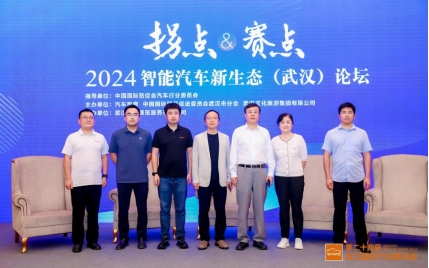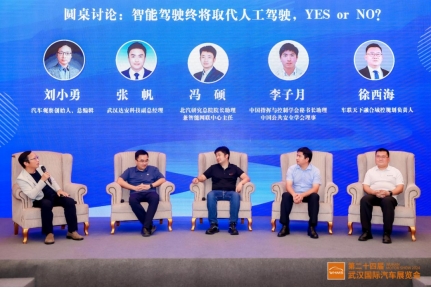Business Development
2024 Wuhan Forum on the New Ecosystem of Intelligent Vehicles
On September 14th, the 24th Wuhan Motor Show grandly opened. As a key official concurrent event of the exhibition, the 2024 Smart Automotive New Ecosystem (Wuhan) Forum was also held at the Wuhan International Conference Center, empowering the exhibition through soft strengths. This forum was guided by the China Council for the Promotion of International Trade Automotive Committee, and jointly organized by Auto Observer, the Wuhan Sub-Council of the China Council for the Promotion of International Trade, and Wuhan Culture & Tourism Group Co., Ltd., with Wuhan World Trade Exhibition Service Co., Ltd. serving as the executive organizer.

In the surging tides of our era, every industrial transformation resonates like thunder in silence. For the automotive sector, the industry is currently navigating a pivotal transition from the "first half" to the "second half" of its evolution. For enterprises, this is a decisive "critical moment" that determines survival. Transformation is no longer optional but imperative. How to steer direction amid the wave of intelligence and maintain advantages in fierce global competition has become key to seizing opportunities and securing the future.
Under the theme "Turning Point and Critical Moment," government and industry leaders, corporate representatives, and experts gathered to explore new trends in smart automotive development and opportunities within the intelligent ecosystem, collectively addressing the industry’s inflection point.
Chai Zhanxiang, Assistant President of the China Council for the Promotion of International Trade Automotive Committee; Shen Bin, Secretary-General of the Wuhan Sub-Council; and Zhao Lejun, Deputy General Manager of Wuhan Culture & Tourism Group, delivered opening remarks.
Cha Zhanxiang shared several insights on the latter phase of intelligent transformation: Firstly, original and fundamental technologies serve as the cornerstone for intelligent competition; secondly, the next stage of intelligent development encourages open collaboration and joint innovation; thirdly, balanced advancement should be pursued to ensure parity between electric and traditional vehicle intelligence; finally, intelligent evolution must remain user-centric while preserving its original purpose. "The coming five to ten years will witness intelligent technologies taking center stage. We aim to convert first-mover advantages into comprehensive leadership across market presence and technological prowess, propelling intelligent and electric technologies as dual engines driving China’s automotive prowess," stated Cha Zhanxiang.
Zhao Lejun stated that the industry is at a critical juncture of old-to-new energy transition. "The turning point is here, and the future has arrived. Only through innovation—enhancing functionality with intelligence, merging technology with tradition, and replacing old energy with new—can we seize opportunities and secure victory." He added that Wuhan Culture & Tourism Group is eager to collaborate with automakers to co-create a new vision for "tourism on wheels."
Feng Shuo, representing automakers, outlined trends: progression from combined assisted driving to advanced autonomous systems, widespread adoption of Navigate on Autopilot (NOA), AI-driven cabin experiences, centralized electronic/electrical architectures, and data-closed-loop technologies. However, challenges remain, including end-to-end algorithm optimization, AI cabin applications, and centralized architecture implementation. "BAIC aims to deliver high-safety, high-comfort intelligent driving products and agile, human-like interactive cabins, leveraging data loops to accelerate innovation," he noted.
Xu Xihai, addressing supply chain pressures, highlighted opportunities in integrated E/E architectures and AI-defined vehicles. "Price wars demand cost efficiency, yet the shift to centralized architectures and software-to-AI transitions offer immense potential."* He shared Tinnova’s strategy: platform-based development aligned with EEA trends, modular innovation, and partnerships like Qualcomm’s 4th-gen cockpit-drive fusion solutions.
The intelligent vehicle industry is currently experiencing rapid development, with continuous technological breakthroughs and intensifying market competition. However, will autonomous driving ultimately replace human drivers? Under the moderation of Liu Xiaoyong, founder of Automotive Observer, multiple experts from various fields of vehicle intelligence engaged in a lively debate using an innovative pro-con discussion format.
As a representative of technology companies, Xu Xihai firmly believes autonomous driving will inevitably replace human operation, citing three key reasons: increasing support from both industry and government levels; significant breakthroughs in core technologies like algorithms, computing power, and data; and the evolving nature of vehicles as mobility tools. He predicts diminishing emphasis on privacy and driving pleasure, with growing prioritization of sharing economy and practicality, which will ultimately drive autonomous driving implementation.

Addressing widespread safety concerns, Xu drew parallels with electric vehicles: "A decade ago, EVs were less safe, yet adoption accelerated regardless. Development progresses through iterative improvement rather than resolving all issues beforehand."
Li Ziyue, representing industry institutions, concurred with complete replacement. Citing breakthroughs in general artificial intelligence post-large language models, he explained: "Previously insurmountable obstacles like the Turing test have been overcome. With forthcoming milestones in AGI, coupled with enhanced reliability, rapid functional iteration, and cost reduction in autonomous technologies, human driving replacement becomes inevitable."
Regarding implementation paths, Li advocated gradual progression from L2+ to full autonomy to mitigate safety risks.
Feng Shuo, speaking for OEMs, emphasized prerequisite conditions for replacement: "We must define specific application scenarios, establish data sharing mechanisms, and develop safety evaluation standards. Only through clarifying these parameters can credible replacement occur."
Predicting industry trends, Feng forecasted L3 autonomous driving will expand beyond limited road sections within 3-5 years, while urging the supply chain to foster collaborative ecosystems rather than focusing solely on individual products.
Zhang Fan from testing institutions proposed a nuanced perspective - autonomous systems will "assume" rather than completely "replace" human functions. He highlighted four foundational requirements: "True autonomy requires achieving safety, convenience, efficiency, and sustainability simultaneously. Current functional safety remains incomplete, with anticipated functional safety still uncharted territory."
Challenging commercial assumptions, Zhang questioned actual market demand: "How many consumers truly need intelligent vehicles?" He further critiqued industry innovation, noting intelligent vehicles have yet to achieve substantive breakthroughs in efficiency, business models, or product innovation.
The spirited debate culminated in moderator Liu Xiaoyong's concluding remarks: "In any technological field, sustainable development requires embracing uncertainty and contention. Our distinguished panelists have not only inspired industry progress but also illuminated opportunities for practitioners to capture intelligent transformation potential."
- Previous:The 10th China (Wuhan) International New Energy & Intelligent Connected Vehicle Development and Cooperation Summit 2024 Successfully Convenes
- Next:Wuhan-Guangzhou Agricultural and Food Industry Chain Cooperation Exchange Conference & CIFEX (Guangzhou) Wuhan Promotion Event Successfully Held in Wuhan
-
WeChat Official Account

-
Tel
027-85857388 -
Email
-
